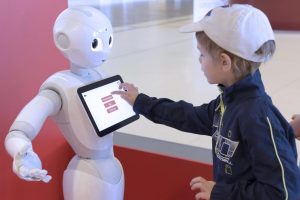Artificial Intelligence (AI) has rapidly evolved from a niche area of computer science to a transformative force reshaping various aspects of society and industry. As we delve into the future of AI, it’s essential to explore its implications, benefits, challenges, and how it is revolutionizing the way we live and work. This comprehensive exploration will delve into specific use cases across multiple sectors, analyze the benefits and risks associated with AI, and discuss future trends that are poised to redefine our relationship with technology.
Understanding Artificial Intelligence

AI refers to the simulation of human intelligence processes by machines, particularly computer systems. These processes include learning (the acquisition of information and rules for using it), reasoning (using rules to reach approximate or definite conclusions), and self-correction. The evolution of AI can be traced back to the early days of computing, with significant milestones including:
- 1951: The first documented success of an AI program was achieved by Christopher Strachey, who created a checkers program.
- 1997: IBM’s Deep Blue defeated chess grandmaster Garry Kasparov, showcasing the potential of AI in complex problem-solving.
- 2011: IBM Watson won Jeopardy!, marking a significant advance in natural language processing.
- 2018: OpenAI released its first Generative Pre-trained Transformer (GPT) models, leading to the proliferation of AI generators capable of creating text, audio, and images.
Table 1: Milestones in AI Development
| Year | Milestone | Description |
|---|---|---|
| 1951 | First AI Program | Christopher Strachey’s checkers program. |
| 1997 | Deep Blue Defeats Kasparov | Demonstrated AI’s capabilities in strategic thinking. |
| 2011 | IBM Watson Wins Jeopardy! | Showcased advancements in natural language processing. |
| 2018 | OpenAI’s GPT Models | Paved the way for generative AI applications. |
The Impact of AI on Various Industries
AI is increasingly becoming integral to numerous industries, each reaping its benefits and facing its challenges. Below, we explore some key sectors transformed by AI technology.
1. Healthcare
AI’s application in healthcare is revolutionizing diagnostics and patient care. AI systems analyze vast amounts of medical data to identify patterns and make predictions about patient outcomes. For example, AI algorithms can analyze medical images for early detection of conditions like cancer, often with greater accuracy than human radiologists.
Benefits of AI in Healthcare:
- Enhanced Diagnostics: AI can help identify diseases at earlier stages, improving treatment outcomes. For example, Google Health developed an AI that can detect breast cancer in mammograms more accurately than human radiologists.
- Improved Patient Monitoring: AI-powered virtual assistants can track patients’ health remotely, providing timely alerts to healthcare providers. Wearable devices with AI capabilities can monitor vital signs and alert medical personnel in case of anomalies.
- Accelerated Drug Discovery: AI algorithms can simulate how different compounds might interact, speeding up the research process. Companies like Atomwise utilize AI to predict which drug formulations might be effective against diseases.
2. Finance
In the finance sector, AI is being used for risk assessment, fraud detection, and personalized banking experiences. AI algorithms analyze transaction data in real-time to identify unusual patterns that may indicate fraudulent activity.
Examples of AI in Finance:
- Fraud Detection: Systems like FICO Falcon detect anomalies in transactions, alerting banks to potential fraud. Machine learning algorithms continuously improve as they analyze more data, making these systems increasingly effective.
- Robo-Advisors: Automated platforms like Betterment and Wealthfront use algorithms to manage investment portfolios based on individual risk preferences, offering personalized investment strategies without human intervention.
Benefits of AI in Finance:
- Risk Management: AI enhances risk assessment models by analyzing vast datasets to predict potential risks and returns.
- Customer Personalization: AI allows banks to offer tailored services based on customer preferences and behaviors, enhancing customer satisfaction.
3. Manufacturing
AI in manufacturing enhances operational efficiency through predictive maintenance and automation. Smart factories equipped with AI systems can predict equipment failures before they occur, minimizing downtime and reducing costs.
Benefits of AI in Manufacturing:
- Predictive Maintenance: AI analyzes equipment data to forecast when maintenance is needed, reducing unplanned downtime. GE uses AI in its jet engine production to predict when parts will need maintenance, resulting in significant cost savings.
- Quality Control: AI systems can monitor production quality in real-time, reducing defects and waste. Companies like Siemens are integrating AI-driven quality control measures in their production lines.
Table 2: Industry Applications of AI
| Industry | Applications | Benefits |
|---|---|---|
| Healthcare | Diagnostics, Virtual Assistants | Early disease detection, patient care |
| Finance | Fraud Detection, Robo-Advisors | Security, personalized banking |
| Manufacturing | Predictive Maintenance, Quality Control | Reduced downtime, improved quality |
4. Education

AI is transforming education through personalized learning experiences. AI tools can assess student performance and tailor educational content to meet individual needs.
Examples of AI in Education:
- Adaptive Learning Platforms: Systems like DreamBox Learning adjust the curriculum based on a student’s progress and learning style, ensuring that students receive targeted support.
- Plagiarism Detection: Tools like Turnitin utilize AI to compare student submissions against a vast database of sources to identify potential plagiarism, promoting academic integrity.
Benefits of AI in Education:
- Customized Learning Paths: AI can help identify students’ strengths and weaknesses, allowing educators to tailor their teaching methods accordingly.
- Administrative Efficiency: AI automates administrative tasks such as grading and attendance tracking, allowing educators to focus more on teaching.
5. Customer Service
AI enhances customer service through chatbots and virtual assistants, providing immediate responses to customer inquiries. These systems can handle a variety of tasks, from answering common questions to processing orders.
Benefits of AI in Customer Service:
- 24/7 Availability: Chatbots can assist customers at any time, improving customer satisfaction. For instance, companies like Sephora use AI-driven chatbots on their websites to provide product recommendations and answer queries.
- Cost Reduction: Automating responses to common inquiries reduces the need for extensive customer service teams, enabling businesses to allocate resources more effectively.
6. Transportation
The transportation industry is experiencing a significant transformation due to AI advancements, particularly in autonomous vehicles and logistics optimization.
Examples of AI in Transportation:
- Autonomous Vehicles: Companies like Tesla and Waymo are at the forefront of developing self-driving cars equipped with AI technologies that can analyze vast amounts of data from sensors and cameras to navigate roads safely.
- Logistics Optimization: AI systems analyze data to optimize shipping routes and reduce delivery times, enhancing overall efficiency. Amazon uses AI algorithms for inventory management and to predict demand for products.
7. Retail
AI is reshaping the retail landscape by enhancing customer experience and streamlining operations.
Benefits of AI in Retail:
- Personalized Shopping Experiences: AI analyzes customer data to provide personalized recommendations, enhancing customer satisfaction and loyalty. For example, Netflix uses AI algorithms to suggest shows based on viewing history.
- Inventory Management: AI can predict demand for products, enabling retailers to manage inventory more effectively and reduce waste.
The Challenges and Risks of AI
While AI offers numerous advantages, it also presents several challenges and risks that must be addressed.
1. Job Disruption
As AI automates routine tasks, there are concerns about job displacement. A study suggests that approximately 44% of workers may have their skills disrupted by AI in the coming years. While manual jobs are more susceptible, the demand for skilled positions, such as machine learning specialists, is likely to grow.
Analysis Table: Job Disruption by Industry
| Industry | Likely Job Losses | Job Creation Opportunities |
|---|---|---|
| Customer Service | Low-skilled positions | AI developers, data analysts |
| Manufacturing | Manual labor roles | Robotics engineers |
| Finance | Traditional banking roles | AI risk analysts |
| Healthcare | Administrative jobs | AI healthcare specialists |
2. Data Privacy Issues
AI requires vast amounts of data for training, raising significant data privacy concerns. Recent investigations into AI companies like OpenAI have highlighted potential violations of data protection laws, prompting discussions on the need for stricter regulations.
Concerns About Data Privacy:
- Consumer Data Collection: Companies must be transparent about how they collect and use consumer data. The General Data Protection Regulation (GDPR) has set a precedent for strict data handling and privacy practices.
- Data Security Breaches: Improper handling of data can lead to significant breaches, exposing sensitive information. The impact of such breaches can be devastating for companies and individuals alike.
3. Bias and Ethical Concerns
AI systems can inadvertently perpetuate biases present in their training data. For example, facial recognition technology has shown disparities in accuracy across different demographics. This bias can lead to unfair treatment in critical areas like hiring and law enforcement.
Addressing Bias in AI:
- Diverse Training Data: Ensuring that AI systems are trained on diverse datasets can help mitigate bias. Companies like Microsoft are actively working to create more inclusive datasets to train their AI models.
- Ethical Guidelines: Organizations must develop ethical guidelines to govern AI development and deployment. Initiatives such as the Partnership on AI aim to promote best practices and standards in AI development.
4. Regulation and Governance
As AI technology evolves, regulatory frameworks must also adapt. Governments are grappling with how to create policies that encourage innovation while protecting public interests. The Biden-Harris administration’s AI Bill of Rights emphasizes the importance of data privacy and responsible AI use.
Key Areas of Focus in AI Regulation:
- Accountability: Establishing clear accountability for AI decisions, especially in critical areas like healthcare and criminal justice.
- Transparency: AI systems must be transparent in their decision-making processes to build trust with users and stakeholders.
The Future of AI: Trends and Predictions

As we look to the future, several trends are emerging in AI that could shape its trajectory over the next decade:
1. Increased Adoption of Generative AI
Generative AI is set to become a cornerstone of creativity across industries. Its ability to produce content—text, images, and music—will revolutionize fields such as marketing, entertainment, and design.
Potential Applications:
- Content Creation: Tools like OpenAI’s GPT models can assist marketers in generating engaging copy and improving content strategies.
- Art and Design: AI can create original artwork based on specific themes, aiding designers and artists. Programs like DALL-E enable users to generate images from textual descriptions, providing new avenues for artistic expression.
2. Collaboration Between Humans and AI
The future will likely see an increase in human-AI collaboration. AI will augment human capabilities rather than replace them, enabling workers to focus on higher-value tasks.
Examples of Collaboration:
- AI-Assisted Decision Making: AI can provide data-driven insights, allowing professionals to make informed decisions faster. In sectors like finance and healthcare, AI can analyze vast datasets to uncover trends and insights that humans might overlook.
- Creativity Enhancement: AI tools can support creative processes by suggesting ideas or variations. For instance, in advertising, AI can generate multiple ad copy variations, enabling marketers to choose the most effective ones.
3. Focus on Ethical AI
As AI’s influence grows, there will be a greater emphasis on developing ethical AI systems. Organizations will prioritize transparency, accountability, and fairness in AI deployments.
Key Focus Areas:
- Bias Mitigation: Ongoing efforts to identify and reduce bias in AI algorithms will be critical to ensuring fairness in AI applications.
- Data Protection: Stricter data privacy regulations will safeguard consumer information, ensuring that companies prioritize ethical data handling practices.
4. AI in Climate Change Mitigation
AI has the potential to play a significant role in addressing climate change. From optimizing energy use in smart grids to improving climate modeling, AI technologies can help develop sustainable solutions.
Examples of AI in Climate Initiatives:
- Energy Efficiency: AI can optimize energy consumption in buildings by analyzing usage patterns and adjusting systems accordingly.
- Predictive Analytics for Environmental Monitoring: AI algorithms can analyze satellite data to predict natural disasters, allowing for better preparedness and response efforts.
Conclusion
Artificial Intelligence is undeniably transforming our world, with its potential reaching across industries and aspects of daily life. While the benefits are profound, the challenges cannot be overlooked. As we navigate the future of AI, a balanced approach that fosters innovation while ensuring ethical standards and data privacy will be crucial.
The road ahead promises exciting developments, but it is imperative that we address the risks and challenges to harness AI’s full potential for the betterment of society. As we continue to explore the capabilities of AI, its successful integration into our lives will depend on collaboration between technologists, policymakers, and the public, ensuring that we shape a future that is equitable, innovative, and sustainable.




